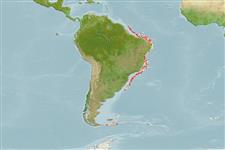Actinopterygii (ray-finned fishes) >
Aulopiformes (Grinners) >
Chlorophthalmidae (Greeneyes)
Etymology: Chlorophthalmus: Greek, chloros = green + Greek, ophthlamos = eye (Ref. 45335).
Environment / Climate / Range
Ecology
Marine; bathydemersal; depth range 366 - ? m (Ref. 46206). Deep-water, preferred ?
Southwest Atlantic: Brazil.
Size / Weight / Age
Maturity: Lm ? range ? - ? cm
Max length : 24.2 cm TL male/unsexed; (Ref. 115012); max. published weight: 91.50 g (Ref. 115012)
Minimum depth from Ref. 58018.
Life cycle and mating behavior
Maturity | Reproduction | Spawning | Eggs | Fecundity | Larvae
Sato, T. and T. Nakabo, 2002. Paraulopidae and Paraulopus, a new family and genus of aulopiform fishes with revised relationships within the order. Ichthyol. Res. 49(1):25-46. (Ref. 41636)
IUCN Red List Status (Ref. 115185)
CITES (Ref. 94142)
Not Evaluated
Threat to humans
Harmless
Human uses
More information
Common namesSynonymsMetabolismPredatorsEcotoxicologyReproductionMaturitySpawningFecundityEggsEgg development
Age/SizeGrowthLength-weightLength-lengthLength-frequenciesMorphometricsMorphologyLarvaeLarval dynamicsRecruitmentAbundance
ReferencesAquacultureAquaculture profileStrainsGeneticsAllele frequenciesHeritabilityDiseasesProcessingMass conversion
Tools
Special reports
Download XML
Internet sources
Estimates of some properties based on models
Phylogenetic diversity index (Ref.
82805): PD
50 = 0.5000 [Uniqueness, from 0.5 = low to 2.0 = high].
Bayesian length-weight: a=0.00617 (0.00199 - 0.01914), b=3.09 (2.84 - 3.34), in cm Total Length, based on LWR estimates for this (Sub)family-body shape (Ref.
93245).
Trophic Level (Ref.
69278): 3.6 ±0.5 se; Based on size and trophs of closest relatives
Resilience (Ref.
69278): .
Vulnerability (Ref.
59153): Low vulnerability (13 of 100) .
